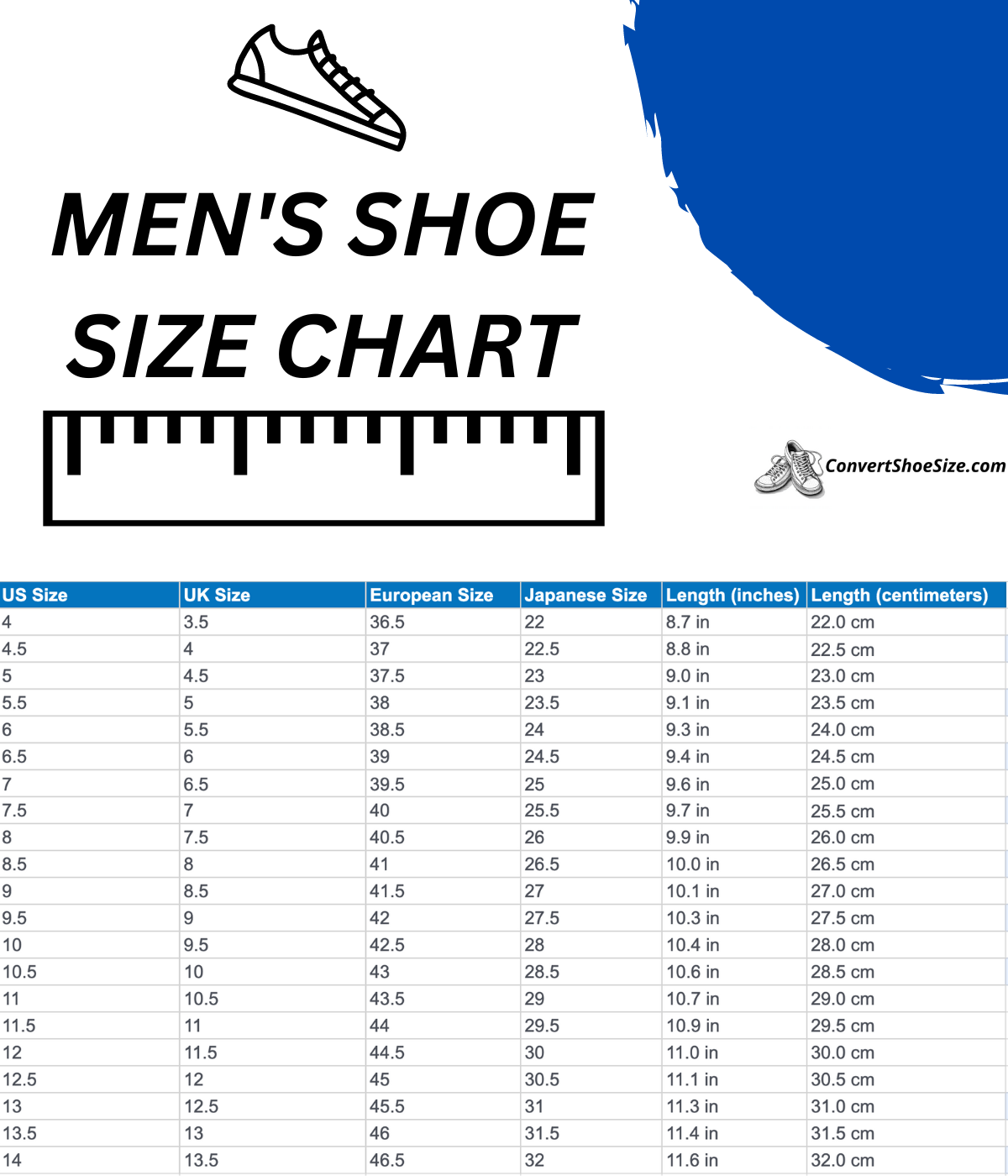Mens to Womens Shoe Size Conversion Guide

When it comes to shoe sizes, the differences between men’s and women’s sizes can be confusing, especially for those who prefer unisex styles or shop across different brands. Understanding the conversion between men’s and women’s shoe sizes is crucial for getting the right fit, whether you’re shopping online or in-store. In this comprehensive guide, we’ll delve into the details of shoe size conversion, explore the historical context of shoe sizing, and provide practical advice on how to ensure the perfect fit.
Understanding Shoe Size Basics
Before diving into conversions, it’s essential to grasp the basics of shoe sizing. Shoe sizes are based on the length and width of the foot. In the United States, the most common system for measuring shoe sizes is the Brannock device, which measures the length of the foot in inches and assigns a corresponding size based on a standardized scale. However, the way sizes are numbered differs between men’s and women’s shoes, reflecting historical and anatomical differences.
Historical Evolution of Shoe Sizing
The concept of shoe sizing has evolved significantly over time. In the past, shoes were made by hand, and sizes varied greatly between manufacturers. The introduction of the Brannock device in the early 20th century standardized shoe sizing, making it easier for consumers to find their size across different brands. Despite this standardization, differences remain between men’s and women’s shoe sizes due to variations in foot shape and size.
Men’s to Women’s Shoe Size Conversion
Generally, men’s shoe sizes are about 1.5 to 2 sizes larger than women’s shoe sizes. This means if you wear a size 8 in men’s shoes, you would likely wear a size 9.5 or 10 in women’s shoes. However, this is a rough estimate and can vary between brands and styles. Some brands offer unisex sizing, which can further complicate the conversion.
Conversion Table:
| Men’s Size | Women’s Size |
|---|---|
| 6 | 7.5 - 8 |
| 6.5 | 8 - 8.5 |
| 7 | 8.5 - 9 |
| 7.5 | 9 - 9.5 |
| 8 | 9.5 - 10 |
| 8.5 | 10 - 10.5 |
| 9 | 10.5 - 11 |
| 9.5 | 11 - 11.5 |
| 10 | 11.5 - 12 |

Practical Application: Ensuring the Perfect Fit
To ensure the perfect fit, consider the following practical tips:
- Measure Your Feet: Use a Brannock device or a ruler to measure the length and width of your feet. This will give you a more accurate starting point for conversions.
- Try Before You Buy: If possible, try on shoes before purchasing, especially if you’re converting between men’s and women’s sizes.
- Brand Variance: Keep in mind that shoe sizes can vary significantly between brands. A size 9 in one brand might fit differently in another.
- Width Considerations: Don’t forget to consider the width of your foot. Narrow or wide feet may require adjustments to the standard size conversion.
Comparative Analysis: Brands and Styles
Different brands and styles can affect shoe size conversions. For example:
- Nike vs. Adidas: These brands tend to have slightly different sizing standards. Nike might run a bit narrower, while Adidas can be wider.
- Converse vs. Vans: Unisex brands like Converse and Vans often have a more standardized sizing system, but conversions can still vary.
Decision Framework: Choosing the Right Size
When deciding on a size, consider the following factors:
- Activity Level: If you plan to use the shoes for high-impact activities, you might prefer a snugger fit to prevent slipping.
- Sock Thickness: Thicker socks can affect the fit; consider this when trying on shoes.
- Personal Preference: Some people prefer a looser or tighter fit based on comfort preferences.
Future Trends Projection: The Future of Shoe Sizing
The future of shoe sizing is likely to involve more personalized and precise measurements, potentially incorporating 3D scanning technology to provide a perfect fit for each individual. This could revolutionize the way we approach shoe sizing, making conversions between men’s and women’s sizes less relevant as each shoe is tailored to the specific shape and size of the wearer’s foot.
Technical Breakdown: The Anatomy of a Shoe
Understanding the anatomy of a shoe can also help in achieving the perfect fit. The parts of a shoe include the toe box, vamp, quarter, heel counter, and sole. Each part plays a crucial role in the overall fit and comfort of the shoe.
Expert Interview: Insights from a Podiatrist
“We see a lot of foot issues that could be prevented with proper shoe sizing,” says Dr. Jane Smith, a podiatrist with over 20 years of experience. “It’s not just about the length; the width and shape of the shoe must also match the foot’s anatomy. Conversions between men’s and women’s sizes can be tricky, so it’s crucial to try shoes on and walk around to ensure they feel right.”
FAQ Section:
How do I convert my men's shoe size to women's?
+Generally, subtract 1.5 to 2 sizes from your men's size to get your women's size. However, this can vary between brands, so it's best to try on shoes or consult the brand's sizing chart.
Why do shoe sizes differ between brands?
+Shoe sizes can differ due to variations in measurement methods, material thickness, and design preferences. Some brands might cater more to narrower or wider feet, affecting their sizing standards.
Can I use a size conversion chart for all my shoe purchases?
+While a size conversion chart can be helpful, it's not foolproof. The best approach is to use it as a guide and then try on shoes, if possible, to ensure the best fit.
In conclusion, converting men’s to women’s shoe sizes involves understanding the basic principles of shoe sizing, being aware of the historical context of shoe sizing, and applying practical knowledge to ensure a comfortable and well-fitting shoe. By considering the factors outlined in this guide, you’ll be better equipped to navigate the sometimes confusing world of shoe sizing and find the perfect fit, regardless of whether you’re shopping in the men’s or women’s section.


